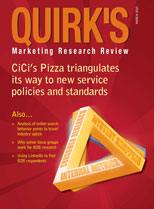Editor's note: Michaela Mora is president of Dallas research company Relevant Insights LLC. This article appeared in the March 22, 2010, edition of Quirk's e-newsletter.
Reshaping - or completely reinventing - a brand's identity can be a long and arduous process, and one that should be guided by sound, comprehensive research. Customer loyalty, emotional attachment to a brand's image, reach, affinity and the ever-mystical cool factor all must be considered and adequately addressed. One way to safeguard against (re)branding blunders is by using a hybrid research approach that incorporates both qualitative and quantitative research.
A damaging effect
Failing to conduct appropriate research in a rebranding campaign can have a damaging effect. Research asks the questions, but they have to be the right questions deployed via the right methodology. For example, in 2009, PepsiCo received a lot of buzz thanks to a couple of marketing stumbles for two of its big brands: Tropicana and Gatorade. In both cases, the brands got makeovers that stripped their brand identity for the sake of simplicity and gave them a more generic look. The makeovers, however, were deemed unsuccessful as sales for both products suffered. In the case of Gatorade, now called G, PepsiCo moved ahead with the new packaging and label, citing G's coolness factor as one of its main attributes. But what is that really saying? Perhaps brand recognition is more important than coolness, given the impact it is likely to have on sales. Also, coolness may be a key driver for one segment but not another.
An effective approach to branding research combines both qualitative and quantitative techniques. Neither alone gives a solid answer. When faced with a brand makeover, consider following this research plan:
Define the problem. First, make sure it is an image problem and not a problem with the product or service. Does the brand need an updated look to attract new market segments? Does the brand elicit negative associations due to blunders from the past and need a fresh start? Does the brand need to be aligned with a new vision and mission for the company? The answers to these questions will define how much of a radical makeover your brand can afford without alienating customers.
Explore current brand perceptions, usage patterns, customer experience and problem areas. This will give you a feel for the brand legacy and how much you can depart from it. Depending on your target market and budget, some of the data collection techniques you can use might include focus groups, in-depth interviews or on-site research (ethnography).
Create several new brand concepts and test them. Use the results from the initial qualitative research to develop different branding concepts. Explore initial reactions to the
concepts, fine-tune them and test them again using qualitative techniques.
Follow-up with quantitative research. Use a large enough sample to select a winner and project the results to your target population. Define the screening criteria of your sample carefully. To certain market segments, some brand attributes may be more relevant than to others, so make sure all segments are represented to avoid biased results. The combination of qualitative and quantitative research techniques will give you in-depth insight and a solid foundation for decision-making. Don't be tempted to only run a couple of focus groups or an online survey and feel you know everything. Conducting branding research with the right approach will pay off and prevent you from making mistakes that will hurt the bottom line.
Advantages and drawbacks
A rebranding campaign has the power to either bring a brand back to life or relegate it to live in infamy in the company of New Coke and Crystal Pepsi. Consider the advantages and drawbacks of qualitative and quantitative research and use the best of both methodologies to ensure that you move in the right direction.
